2008 UN
2008 CTAUN Conference
Friday, 1 February 2008
Teaching and Learning in an Interdependent World
Summary of Conference Proceedings
Welcome
Anne-Marie Carlson
Conference Chair.
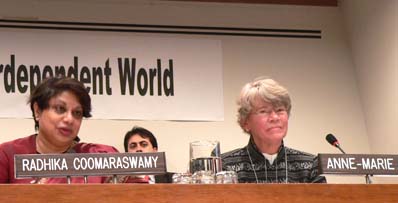 The program was opened with a welcome to all those in attendance by Mrs. Anne-Marie Carlson, Conference Chair and Chair of CTAUN. Mrs. Carlson announced that there were 478 people registered for the conference, including educators from all over the United States, as well as from Canada, Denmark and Japan. For the past four years CTAUN has been cooperating with the Institute of International Education (IIE), and through that partnership a group of thirty-five Fulbright teachers and scholars were in attendance representing twenty countries from all parts of the world. Twenty-three United Nations interns from various countries were also on hand to assist at the conference.
The program was opened with a welcome to all those in attendance by Mrs. Anne-Marie Carlson, Conference Chair and Chair of CTAUN. Mrs. Carlson announced that there were 478 people registered for the conference, including educators from all over the United States, as well as from Canada, Denmark and Japan. For the past four years CTAUN has been cooperating with the Institute of International Education (IIE), and through that partnership a group of thirty-five Fulbright teachers and scholars were in attendance representing twenty countries from all parts of the world. Twenty-three United Nations interns from various countries were also on hand to assist at the conference.
Mrs. Carlson stated that, of the many crises facing children and youth, those singled out for particular attention at this conference were issues related to health and nutrition, literacy, security, and the rights of the child. Attention was drawn to the list of exhibitors at the conference Information Fair.
Opening Address
Radhika Coomaraswamy
Under-Secretary-General and Special Representative of the Secretary-General for Children and Armed Conflict.
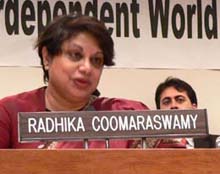 Under-Secretary-General Radhika Coomaraswamy welcomed the audience very warmly to the United Nations. She said that she had been raised there by attending the United Nations International School (UNIS) and had graduated from the Trusteeship Council hall. She therefore feels uniquely qualified for her aim to open the teachers’ imaginations to “the art of the possible” by defining her values and chosen career. “The U.N. is many things,” she stated. “It is also an idea.” It establishes how we deal with “peace and security, human rights, and the development and maintenance of the economy and the quality of life of its members, not just nations.”
Under-Secretary-General Radhika Coomaraswamy welcomed the audience very warmly to the United Nations. She said that she had been raised there by attending the United Nations International School (UNIS) and had graduated from the Trusteeship Council hall. She therefore feels uniquely qualified for her aim to open the teachers’ imaginations to “the art of the possible” by defining her values and chosen career. “The U.N. is many things,” she stated. “It is also an idea.” It establishes how we deal with “peace and security, human rights, and the development and maintenance of the economy and the quality of life of its members, not just nations.”
About ten years ago, Nelson Mandela brought to global attention the already widespread problem of children being drawn into armed conflict. The world was outraged by the killing, maiming and abduction of children, particularly in conditions of war. Radhika illustrated the issues by telling two stories. The first was about Moi, a young man from northern Uganda, who was playing with his childhood friend when rebels raided their village. They took both boys, and then the commander killed the friend who was too weak to keep up. Soon Moi was forced to raid his own village filled with people he knew. As he explained later, “Madam, what am I to do? The only thing I know how to do is to fight.”
In the Congo, Eva, at about twelve or thirteen, was walking to school and was abducted into a camp where any man who wished access could have her and also she was pressed into forced labor. By the age of thirteen she was pregnant, somehow ran away from the military camp and was eventually picked up by a truck. Luckily she found villagers who could and would help. Because of a wonderful doctor who kept the child, she had her baby and is now back in school.
Now there is an office at the U.N. that deals directly with Children and Armed Conflict (CAAC). It reports incidents world wide, publishes a “list of shame” on the basis of questions asked of parties and governments that have recruited child soldiers, and has provided action plans for demobilization. Armed with U.N. Resolution 1512, Radhika advocates for the CAAC, monitoring needs and providing information to the Security Council. In the last five years there have been fifteen new situations that are causing great political problems. Radhika said, however, that she has noticed more political will in the last few years, and the International Criminal Court (ICC) has begun to act, prosecuting its first case on child soldiers. Finally, by mandate in the 2005 Summit Outcome Document, the “concept of the responsibility to protect” has been developed. Her office of Children and Armed Conflict monitors and reacts and the dialogue has begun. Now, as she explained, how to galvanize and keep mobilized is the challenge, and Radhika expressed the hope that all the conference attendees would help.
Mrs. Sylvia Gordon
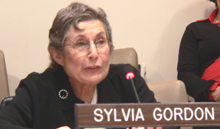 Mrs. Sylvia Gordon, a CTAUN Director at Large, was Radhika’s high school history teacher at UNIS and appeared with her on the stage. In her remarks at the conclusion of the presentation, Sylvia commented on “the pride and joy a teacher has in meeting a former student in her venue.” She added, “It takes a person of great intelligence, training and humanity to maneuver the U.N. to get something done.” Together they presented an inspiring example of how teacher and student have connected, and how the idealism and attitudes needed to work through the perpetual world struggles are instilled.
Mrs. Sylvia Gordon, a CTAUN Director at Large, was Radhika’s high school history teacher at UNIS and appeared with her on the stage. In her remarks at the conclusion of the presentation, Sylvia commented on “the pride and joy a teacher has in meeting a former student in her venue.” She added, “It takes a person of great intelligence, training and humanity to maneuver the U.N. to get something done.” Together they presented an inspiring example of how teacher and student have connected, and how the idealism and attitudes needed to work through the perpetual world struggles are instilled.
Morning Panel
Climate Change: Rethinking the World We Share
Ms. Carolyn Donovan
CTAUN Second Vice-Chair and NGO Representative for the American Association of University Women (AAUW), Moderator.
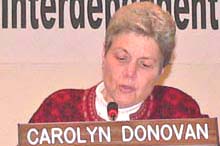 Ms. Donovan gave a historical introduction, focusing on how social and economic awareness has increased in the last 25 years. She stressed that climate change is a number one priority for Secretary-General Ban. He would like to see all nations take clear steps to become carbon neutral. The United Nations is a natural forum where forward progress can be decided upon and made. All nations need to work together and the U.N. can spearhead the awareness of environmental awareness and behavior.
Ms. Donovan gave a historical introduction, focusing on how social and economic awareness has increased in the last 25 years. She stressed that climate change is a number one priority for Secretary-General Ban. He would like to see all nations take clear steps to become carbon neutral. The United Nations is a natural forum where forward progress can be decided upon and made. All nations need to work together and the U.N. can spearhead the awareness of environmental awareness and behavior.
Dr. Alan Robock
Professor of Climatology in the Department of Environmental Sciences at Rutgers University and Associate Director for its Center for Environmental Prediction.
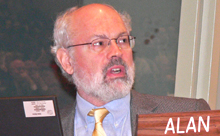 Dr. Robock focused his presentation on global warming, opening with the idea that climate change is gradual but continuous. The definition he gave of global warming is that the global average temperature has been going up over the last one hundred years. Some of this has been from natural causes. He stated that global temperature increase is also influenced when the trophosphere becomes polluted. The EPA, which was formed in 1970, has stopped many pollutants which were contributing to climate change.
Dr. Robock focused his presentation on global warming, opening with the idea that climate change is gradual but continuous. The definition he gave of global warming is that the global average temperature has been going up over the last one hundred years. Some of this has been from natural causes. He stated that global temperature increase is also influenced when the trophosphere becomes polluted. The EPA, which was formed in 1970, has stopped many pollutants which were contributing to climate change.
With glacial melting, extinctions of species will be more obvious, there will be more precipitation, and stronger hurricanes. Coastlines will be vastly different globally. This will become a security issue in all parts of the world. We should begin mitigation now. We need to reduce our impact on natural environments, including the atmosphere. We need to become energy efficient, and to adapt our current practices. There was an energy panel on climate change in 1988 where 3,000 scientists from 150 nations conferred on these issues. By 1995 it was evident to the scientists that human activity was “likely” to be the principal cause of greenhouse gases concentrations. By 2007 this was changed to “very likely.” Scripps Institute, and then NOAA, have been monitoring data on global warming since 1958. The carbon dioxide concentration measured last spring was the highest in 20 million years. As the ocean warms, carbon dioxide is released more rapidly and reduced plant cover slows its pickup through photosynthesis.
Dr. Robock presented NASA climate model graphs that show temperature changes, focusing on global mean surface temperature anomalies. Every continent is warmer now. He stated that there has been nothing equal to this phenomenon in 2 million years. Human influence is evident in this upward trend, partly because we have underestimated the rate of global warming. Computer data can be used to project various scenarios. For example, droughts will be widespread, warming tendencies will lead to more severe hurricanes and a higher number of heat waves. The northeast United States will eventually have temperatures like those of Georgia. In the oceans, coral reef destruction will increase since the carbon dioxide making its way into the oceans causes the sea water to become more acidic. In 2007 there was a record low level of sea ice, much lower than had previously been predicted. Many species will be doomed to extinction because of climate change.
Dr. Robock said that moves can be made to slow the rate of warming. He recommended participating fully in the Kyoto and Rio environmental mandates, and providing leadership for working towards solutions. He closed by showing a picture from the Washington D.C. Metro of graffiti referring to global warming in a subway, saying that it reminded him of the words of a song by Bob Dylan, “…The words of the prophets are written on the subway walls.” (The text of this presentation, including the charts used to illustrate climate change, can be found on the following website:http://climatechange.rutgers.edu/resources/presentations.)
Rebecca Pearl
Sustainable Development Program Coordinator at the Women’s Environment and Development Organization (WEDO).
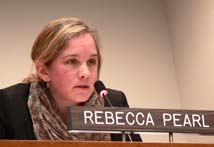 Ms. Pearl is the coordinator of a global advocacy organization that focuses on gender equality and sustainability. Her presentation looked at poverty and vulnerability through the lens on the world’s poorest people. She stated that 70 percent of the world’s poorest people are women. If natural disasters occur, this exacerbates the inequalities of the male/female, wealthy/poor divisions. If there is gender equality males and females are equally affected by any disaster. If not, more females (and their dependent children) die.
Ms. Pearl is the coordinator of a global advocacy organization that focuses on gender equality and sustainability. Her presentation looked at poverty and vulnerability through the lens on the world’s poorest people. She stated that 70 percent of the world’s poorest people are women. If natural disasters occur, this exacerbates the inequalities of the male/female, wealthy/poor divisions. If there is gender equality males and females are equally affected by any disaster. If not, more females (and their dependent children) die.
Women’s contributions are extremely important in affecting climate change. They are the ones who search for resources. They are the ones who walk for water, firewood, and food resources. They conserve water whenever possible. When Hurricane Mitch struck Honduras, the Red Cross had provided an early warning system, and the women were the ones who kept it going. No casualties occurred when these women were prepared. During droughts women often know how to find water, but their input in such matters is often ignored. In Bangladesh when floods came, fatalities data showed that up to 90 percent of the women and children did not leave their homes because they did not know how to swim.
WEDO is trying to put a human face on climate change and to look for ways to help poor women adapt. NGOs around the world can help. Gender equality is essential. We need a network of female ministers of the environment, and governments should be required to be aware of, and provide figures regarding, the range of persons in the population, and that they have different needs. The U.N. needs to come up with publications and accompanying research focused on these issues and provide practical tools to integrate the latest thinking on environmental problems that affect women and that need rapid attention. Internships are available for students who are interested in addressing these issues.
Dr. Steven T. Frantz
Sustainability Education Coordinator for the Scarsdale School District and a member of the Westchester County (NY) Task Force on Global Warming.
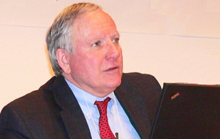 “Sustainability is our responsibility to future generations” was the theme of Dr. Franz’s presentation. The public schools in Scarsdale have taken on the goal of working toward sustainability by providing solution skills to students, educators, and the larger community. The administration and staff believe that educational support will make sustainability happen. They direct their constituents to an awareness of the needs of the present and the importance that present needs must not compromise future generations. Dr. Frantz believes that we have a window of about two or three years to make plans for the future.
“Sustainability is our responsibility to future generations” was the theme of Dr. Franz’s presentation. The public schools in Scarsdale have taken on the goal of working toward sustainability by providing solution skills to students, educators, and the larger community. The administration and staff believe that educational support will make sustainability happen. They direct their constituents to an awareness of the needs of the present and the importance that present needs must not compromise future generations. Dr. Frantz believes that we have a window of about two or three years to make plans for the future.
Scarsdale schools are exploring what is being done negatively, and how this can be turned around. What can be done to get environmental issues into the classroom, faculty meetings, and community meetings? They address issues like energy, water, food, recycling, purchasing, general citizenship, appreciation of nature, biodiversity, and conservation of resources by daily exemplification of best practices.
Dr. Frantz stated that nationally, universities are ahead of public school districts along these lines at present. School districts and teachers feel other pressures from a number of outside sources. In Florida, for instance, science lessons were suspended for seven weeks so that students could fully focus on preparing for the standardized tests.
The staff in Scarsdale works to develop behaviors and attitudes that environmental concerns are everyone’s responsibility. Thus, students as well as staff are responsible for recycling; turning out lights is everyone’s responsibility. The Scarsdale school district took their carbon footprint, and members are working to reduce it. The goal is to be 10 percent lower in 2020 than the 1990 levels. There is a district web site where ideas are available (www.scarsdaleschools.org).
Dr. Frantz closed with a reference to the Dr. Seuss book, The Lorax. “Could it be you?” he asked. He urged those present to be stewards, to be responsible citizens of the world. “What are we waiting for?” he asked. “We need to make decisions now. We are the people we are waiting for!”
Afternoon Panel
Moving Toward Intercultural Understanding
Mrs. Narin Stassis
CTAUN First Vice-Chair and ESL teacher, West Paterson (NJ) School District, Moderator.
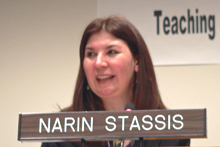 Mrs. Stassis opened by stating that the panel presenters were a unique blend of people who would be addressing different approaches toward reaching for global understanding. She questioned how well students are prepared to interact with other societies. She reminded us that “teachers teach the possible.” Hopefully the panel members would help as we work to act locally and interact globally.
Mrs. Stassis opened by stating that the panel presenters were a unique blend of people who would be addressing different approaches toward reaching for global understanding. She questioned how well students are prepared to interact with other societies. She reminded us that “teachers teach the possible.” Hopefully the panel members would help as we work to act locally and interact globally.
Shira Danan and Elias Ibrahim
Representatives of Abraham’s Vision, a conflict transformation organization.
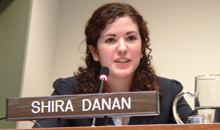 Abraham’s Vision works to help students explore group and individual identities through experiential and political education. Examining social relations within and between groups, participants are empowered to practice just alternatives to the status quo. Two of these students, Shira Danan and Elias Ibrahim, presented an overview of how this organization brings young Muslims, Jews, Palestinians and Israelis together.
Abraham’s Vision works to help students explore group and individual identities through experiential and political education. Examining social relations within and between groups, participants are empowered to practice just alternatives to the status quo. Two of these students, Shira Danan and Elias Ibrahim, presented an overview of how this organization brings young Muslims, Jews, Palestinians and Israelis together.
Along with other participants, Shira and Elias met at an Abraham’s Vision program in the former Yugoslavia as part of a group of eleven Palestinians, eleven Israelis and one facilitator. Through presentations, workshops, and an interactive group process they created an open forum in an unstructured, non-judgmental environment. The group process provided a circle in which anyone could say anything he or she wanted to. They started first with a discussion of the situation in the Balkans, and moved on from there to discussions of their own backgrounds. The understandings they came to were of individual backgrounds and first person stories. They discovered that superficial appearances and modes of dress were unimportant. They saw themselves as part of a group; their interpersonal relationships were part of a much larger picture.
Shira Danan was born and raised in San Antonio, Texas. She is a graduate of Columbia University with a BA in Religion, concentrating on historical and contemporary interfaith relations. Her senior thesis was on programs promoting religious pluralism in New York City high schools.
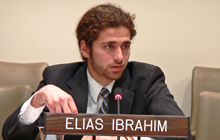 Elias Ibrahim was born in the former USSR to a Russian mother and a Palestinian father and moved to the United States at the age of four. A central issue to him has been the betterment of the Palestinians’ situation. As a fourth-year pre-med biology student at UCLA, he intends to focus on practicing humanitarian medicine in the areas of the world that need it most acutely.
Elias Ibrahim was born in the former USSR to a Russian mother and a Palestinian father and moved to the United States at the age of four. A central issue to him has been the betterment of the Palestinians’ situation. As a fourth-year pre-med biology student at UCLA, he intends to focus on practicing humanitarian medicine in the areas of the world that need it most acutely.
[On March 18, 2008, the conference organizers received the tragic news thatElias Ibrahim had died suddenly due to accidental drowning.We consider it a privilege to have been able to have this outstanding young man as a presenter at our conference, sharing his experiences as a student exploring intercultural understanding and peace among all peoples. We extend our condolences to his family and friends.]
Dr. Lucille E. Davy
New Jersey’s Commissioner of Education.
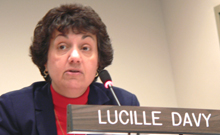 Dr. Davy opened by congratulating the New Jersey teachers who received the CTAUN 2008 Best Practices award and the many teachers who are working for global understanding. She stated that with the increased interaction of peoples through the media, the Internet, and world travel, global literacy is now a “foundational skill.” It is necessary that students become globally literate, that they learn to understand others, that they exhibit informed sensitivity to other cultures and overcome bias and racism and know how to interact with others who are different than they are. The ability to communicate through email helps all our students develop a cognitive connection with others.
Dr. Davy opened by congratulating the New Jersey teachers who received the CTAUN 2008 Best Practices award and the many teachers who are working for global understanding. She stated that with the increased interaction of peoples through the media, the Internet, and world travel, global literacy is now a “foundational skill.” It is necessary that students become globally literate, that they learn to understand others, that they exhibit informed sensitivity to other cultures and overcome bias and racism and know how to interact with others who are different than they are. The ability to communicate through email helps all our students develop a cognitive connection with others.
In the New Jersey schools, the children of immigrants are now the fastest-growing segment of the population. One in five children speaks a language other than English at home. Dr. Davy stated that, in the past, not speaking English has been considered a deficit for children in school. She stated, however, that educators need a new paradigm for looking at children who speak another language. As they learn English, these children will become bilingual, which is an ability that will place them at an advantage. It is necessary for us to consider that speaking a language other than English is an advantage. At the present time throughout New Jersey, foreign language study now starts early, so that native English speaking children can also start to become proficient in another language.
In New Jersey, Governor Corzine has charged the Department of Education that New Jersey students learn not only to live but to prosper in a multicultural world. In the curricula in New Jersey, language arts courses examine how media represents what is taught and social studies courses integrate the past with the present. The New Jersey Department of Education has recently entered into a partnership with Coverdell World Wise Schools to implement their programs for intercultural understanding. In the fall of 2009, New Jersey will launch a Sesame Street world language model called “Global Grover” for pre-kindergarten children.
Jennifer L. Chidsey Pizzo
Director of Data Services and Curriculum Development for the International Studies Schools Network of the Asia Society.
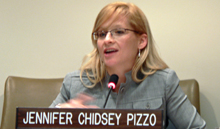 Ms. Chidsey Pizzo opened her presentation by explaining that she heads a new project at the Asia Society, the International Studies School Network (ISSN). The Asia Society was funded by the Gates Foundation to start this national network of “design-driven schools that are achieving success in attaining their core mission: to develop college ready, globally competent high school graduates.” She added that “I am a teacher at heart, and I hope to reinforce these ideals in our schools. The challenge for teachers is: Can your work be reflected in the students you teach?”
Ms. Chidsey Pizzo opened her presentation by explaining that she heads a new project at the Asia Society, the International Studies School Network (ISSN). The Asia Society was funded by the Gates Foundation to start this national network of “design-driven schools that are achieving success in attaining their core mission: to develop college ready, globally competent high school graduates.” She added that “I am a teacher at heart, and I hope to reinforce these ideals in our schools. The challenge for teachers is: Can your work be reflected in the students you teach?”
The ISSN schools are mostly small urban schools, because the poor academic performance of students in many low-income city neighborhoods, as well as some rural communities, has been well documented. In addition, it has become imperative that all students leave high school “prepared to compete and cooperate on a global scale.” Ten schools in the ISSN network have been opened in five states since 2004, with another due to open in 2008. They hope to reach thirty schools within the next five years.
Students in the ISSN high schools learn to work cooperatively to solve global problems. Many of them will be working on climate change. The goal is that the schools have a problem-based curriculum, so that students become collaborative problem solvers with an international perspective. All students will be educated to become fluent in a language other than English and to become technologically proficient.
Ms. Chidsey Pizzo stressed the need for all educators to become more aware of our links to the rest of the world and consider how we can bring this perspective into our classrooms. She encouraged the teachers present at the conference to “Get involved. Look across your grade level or your school and ask ‘What can we do with our existing curriculum that would allow us to give a global perspective?‘ Do something with your faculty as a whole.” She closed by suggesting that interested teachers go to Google, type in “Did You Know? 2.0” and they will pull up an excellent video resource. Teachers might also search for a video titled “Two Million Minutes.” This refers to the two million minutes that are the time that elapses between the ninth and the twelfth grades. In the video, students in China, India and the United States are shown using these two million minutes. She referred teachers to the Asia Society web site, which she said has a “treasure trove” of materials. (www.asiasociety.org/education.)
Closing Keynote Address
Dr. Spencer Wells
Genograhic Project Director for the National Geographic Society and National Geographic’s Explorer in Residence.
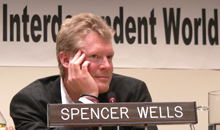 In the introduction we were told that Dr. Wells calls his lecture “The Greatest Story Not Yet Told.” He began by explaining that his job as a population geneticist is “to explain the patterns of human diversity we see when we look around the world….We all seem to be so different from each other. But how different are we? That’s a big question, and answering that question is the goal of population genetics.” As a population geneticist, he now joins traditional knowledge and new research technologies to close the gap in our understanding of human genetics and human migration as it traces our shared ancestry as humans and connects the world’s populations. The Genographic Project explores the question “How different are we?” in our origins and our life journeys. What patterns of diversity emerge after a shared ancestry with apes 23 million years ago and the land shifts of 12 million years ago?
In the introduction we were told that Dr. Wells calls his lecture “The Greatest Story Not Yet Told.” He began by explaining that his job as a population geneticist is “to explain the patterns of human diversity we see when we look around the world….We all seem to be so different from each other. But how different are we? That’s a big question, and answering that question is the goal of population genetics.” As a population geneticist, he now joins traditional knowledge and new research technologies to close the gap in our understanding of human genetics and human migration as it traces our shared ancestry as humans and connects the world’s populations. The Genographic Project explores the question “How different are we?” in our origins and our life journeys. What patterns of diversity emerge after a shared ancestry with apes 23 million years ago and the land shifts of 12 million years ago?
Dr. Wells noted that the traditional approach to studying human ancestry is that of paleoanthropologists, such as the Leakeys and others, who based their work on the study of human bones. He displayed a photograph of three contemporary but dissimilar looking paleoanthropological pre-human skeletons discovered by the Leakey family in Northern Tanzania. It is probable that humans are descended from one of them, but we do not know for sure. To find out, Dr. Wells recommends approaching the ancestry linkage “backwards” to reconstruct the family tree of man so that everyone from the present to the beginning can be fitted into the stream of history. We all carry a clue to our ancestry in every cell in our body through our DNA.
Modern DNA research techniques make this project possible by tracking genetic information in the form of patterned chains of A-adenine, T-thymine, G-guanine, and C-cytosine found in the nucleus of individual cells. Computers find that DNA samples from the human population are, remarkably, 99.9 percent genetically the same. However sometimes a genetic marker, or what Dr. Wells called a “typo,” or “proof reading mistake,” indicates a genetic mutation that makes a single but significant change. These markers are then passed down to our children. If you share a marker with someone, you share an ancestor with them. These markers are genetic signposts by which each of us can be traced back through the generations to our origins on one of the ancestral trees. Furthermore, these significant changes have been noticed to correlate with ancient climatic changes and hence the great migrations, the journeys throughout the world in time and place, can be established. Humans have relatively fewer different genetic markers than other living creatures. We are all virtually identical at the DNA level.
Sub-Saharan Africa is the birthplace of human life. About 60,000 years ago all human beings were living in Africa, but at some point one group of Africans split off. Between 50,000 and 60,000 years ago there were migrations across Asia to Australia, reaching down into Australia about 50,000 years ago. Approximately 45,000 years ago there were migrations to Eurasian areas, and about 20,000 to 15,000 years ago one small group crossed the Bering Straits and populated the western hemisphere, North and South America, probably within about 1,000 years. Dr. Wells explained that he told this fascinating story in a book he wrote a few years ago called The Journey of Man and in a subsequent film for PBS.
Fascinated by the science behind the book and the film, the National Geographic Society asked, “So, Dr. Wells, if you could do anything next, what would it be?” He replied that his studies so far had been based on a few thousand samples from a few populations around the world and that he would like to be able to have at least a few hundred thousand samples from all parts of the world. That was the genesis of the National Geographic Genographic Project.
As a modern “explorer” for the National Geographic Society, Dr. Wells regards the computer analysis of DNA samples as his “high-powered telescope” with which he can uncover human migration before and after recorded history. The educational implications are ever widening. Our raised awareness of indigenous populations and the need to conserve local ethnic groups and endangered people and their languages and cultures are immediate rewards. But in addition to studying the ancestries of indigenous groups worldwide, the Genographic Project is seeking to engage the general public in on-going data collection, with individual participation kits, to encourage us all in the collaborative, interactive, and culturally relevant investigation “so we see we are all connected” in the fullest sense. Out of our joint efforts, we can learn “the story of one family, the human family, seen in many faces.”
Spotlight Presentations
Throughout the day, four brief “spotlight presentations” were made by representatives of four different groups describing the teaching programs implemented by their organizations. CTAUN Member Grace M. Murphy introduced these spotlights.
Spotlight #1: Ms. Yumi Ross
for “Cool Globes”
 Ms. Ross described herself as an architect and an environmental activist. She said that it was a great pleasure for her to be present at the conference because she had been a student at the United Nations International School, and her graduation had taken place in the General Assembly room. She is part of the Cool Globes education team. Cool Globes is a large public arts project which is mounting exhibitions around the country designed to “use public art to inspire individuals and organizations to take action against global warming.” The original exhibit along the lakeshore in Chicago in the summer of 2007 featured 120 sculpted globes, each 5′ in diameter, decorated by well-known artists with themes related to the causes, effects and solutions to the global climate issue. There have since also been smaller globes on exhibit in different places, some designed by high school students and others by younger students.
Ms. Ross described herself as an architect and an environmental activist. She said that it was a great pleasure for her to be present at the conference because she had been a student at the United Nations International School, and her graduation had taken place in the General Assembly room. She is part of the Cool Globes education team. Cool Globes is a large public arts project which is mounting exhibitions around the country designed to “use public art to inspire individuals and organizations to take action against global warming.” The original exhibit along the lakeshore in Chicago in the summer of 2007 featured 120 sculpted globes, each 5′ in diameter, decorated by well-known artists with themes related to the causes, effects and solutions to the global climate issue. There have since also been smaller globes on exhibit in different places, some designed by high school students and others by younger students.
The education team was created to take advantage of the large public art projects to inspire school children to be concerned about global climate issues. The team itself was made up of the Cool Globes representatives, people from the Peggy Notebaert Nature Museum in Chicago and a group of Chicago public school teachers and science curriculum specialists. At the suggestion of the teachers, the teaching curriculum was designed for the sixth grade level, and can be modified for younger and older students. It is a “pick and choose” curriculum with four parts, so that teachers can use as much or as little as time permits. The Cool Globes program has since been initiated in schools and after-school programs in the Chicago area and adopted in other areas as well. A DVD geared for children has also been developed to teach students about global warming using the original Cool Globes as teaching tools. (www.coolglobes.com.) >
Spotlight #2: Marie Bresnahan
Director of Education, U.S. Fund for UNICEF
 Ms. Bresnahan’s primary responsibility is for TeachUNICEF, which is a domestic education program designed to teach America’s school children about UNICEF’s work around the world. The goals of the program are: to create concerned global citizens; to examine root causes and consequences of global situations; and to learn about innovative solutions. The lessons are based on UNICEF’s State of the World’s Children annual reports. Each unit contains: background information for the teacher; in-class discussion guides; interdisciplinary connections; links to UNICEF online resources; and service-based learning opportunities. (Free resources are available for educators at www.teachunicef.org.)
Ms. Bresnahan’s primary responsibility is for TeachUNICEF, which is a domestic education program designed to teach America’s school children about UNICEF’s work around the world. The goals of the program are: to create concerned global citizens; to examine root causes and consequences of global situations; and to learn about innovative solutions. The lessons are based on UNICEF’s State of the World’s Children annual reports. Each unit contains: background information for the teacher; in-class discussion guides; interdisciplinary connections; links to UNICEF online resources; and service-based learning opportunities. (Free resources are available for educators at www.teachunicef.org.)
The current theme for high school and middle school students is “Excluded and Invisible.” The lessons in this curriculum are on the root causes of exclusion, the Millennium Development Goals, and youth stories, featuring real children, on child labor, poverty, armed conflict, and HIV.
Lesson plans related to the world water crisis are scheduled to be launched in March 2008. A future theme will be on gender equality. All topics are treated with dignity, and there is always a message of hope.
Spotlight #3: Ms. Pamela Chappell
Singer, Songwriter and Performer
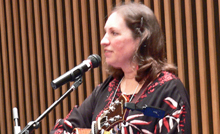 Ms. Chappell has a gift for capturing the hearts of her listeners. Performing solo on her guitar, her music ranges from gentle to powerful and from humorous to profoundly touching. She stated that her personal mantra is “As long as there is music everything is all right.” During her spotlight presentation she sang two songs: “The Fuller Challenge” and “One Person at a Time,” urging the audience to join in with her.
Ms. Chappell has a gift for capturing the hearts of her listeners. Performing solo on her guitar, her music ranges from gentle to powerful and from humorous to profoundly touching. She stated that her personal mantra is “As long as there is music everything is all right.” During her spotlight presentation she sang two songs: “The Fuller Challenge” and “One Person at a Time,” urging the audience to join in with her.
Ms. Chappell’s message is that music brings fun and joy to the classroom. She stated that she believes that “You must be the change you want to see in the world.” Her music reflects this!
Spotlight #4: Victoria Baxter
Program Director of The People Speak
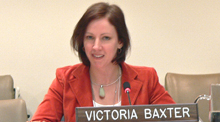 Ms. Baxter opened by saying “Thank you” to the teachers in the audience, saying that she was the product of “teachers just like you, who helped young people see beyond the test and beyond the text, to see themselves as part of the world, part of the global community.” The UN Foundation sponsors “The People Speak” and uses modern methods of technology so young people can connect on global issues. The rationale behind this program is that teenagers want to be taken seriously. They see innovative solutions and ideas and are open to new ways of doing because they don’t see the limits yet that we do as adults. There are many The People Speak programs on their website (www.thepeoplespeak.org). Three of them were presented at the conference.
Ms. Baxter opened by saying “Thank you” to the teachers in the audience, saying that she was the product of “teachers just like you, who helped young people see beyond the test and beyond the text, to see themselves as part of the world, part of the global community.” The UN Foundation sponsors “The People Speak” and uses modern methods of technology so young people can connect on global issues. The rationale behind this program is that teenagers want to be taken seriously. They see innovative solutions and ideas and are open to new ways of doing because they don’t see the limits yet that we do as adults. There are many The People Speak programs on their website (www.thepeoplespeak.org). Three of them were presented at the conference.
The first program Ms. Baxter discussed was The People Speak Global Debates. These are public debates that are totally student driven. She stated that their first global debate was held last October, and there were participants from over seventy countries. Students throughout the countries held debates in their schools about the best ways to lower carbon emissions. The winners of the debates were able to compete for the youth summit described below. The next round of debates will start this spring and is on water rights. This is such a big issue, it is rare that a day passes that there is not something in the news. Ms. Baxter stated that “We hear about the role of women and girls in Africa who spend hours a day hauling water, and thus are not able to go to school. When we have the global debates,students in this country are hearing from students in countries that are living that reality.”
The second program is a media contest called Think Globally, Report Locally. Students create a two-minute video that takes a global issue and finds a local angle.
The third program is a Youth Summit, which this year will be held July 17-19 at the United Nations. About 400 students from the United States and all over the world are expected to attend. About half of them will have participated in the previous two programs, they have thought about global issues, and they are coming to share with others. The focus of this summit is on climate change, highlighting the really unique role the United Nations plays in this area.
Other Highlights
CTAUN’s 2007 Best Practices Award was presented by Phyllis Hickey, CTAUN Member-at-Large.
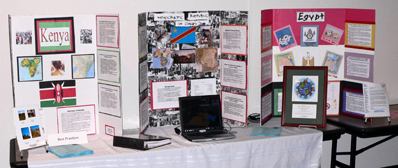 She opened this presentation by explaining that each year CTAUN presents a Best Practices Award to a person or persons who have attended the previous year’s conference and developed an instructional practice or program inspired by some aspect.
She opened this presentation by explaining that each year CTAUN presents a Best Practices Award to a person or persons who have attended the previous year’s conference and developed an instructional practice or program inspired by some aspect.
Best Practices Exhibit
The Best Practices award winners at the 2008 Conference were Debbie Kline and Maria Pyle, social studies teachers at the Community Middle School in the West Windsor-Plainsboro Regional School District, and Mark Wise, Social Studies Supervisor for grades 4-8. The 8th grade social studies curriculum covers the period from 500 to 1500. The teachers restructured the course to reflect the connections between events in the Middle Ages in all parts of the world and present issues around the globe. The overall aim of the curriculum is to connect the Middle Ages with the modern world through the concept of globalization.
The curriculum opens the school year with a unit on “How to Be Self-Directed Learners.” Among other units are an Islam unit that explores how Islam was a force for globalization in the Middle Ages, a unit on Renaissance and exploration and how that changed the world, and a unit on Africa with a focus on the geographic, cultural and historical reasons contributing to the present poverty crisis in many parts of Africa. During the final months of the eighth grade social studies course, students draw from their understanding of the historical context of globalization to view and analyze its impact on the world today. The year ends with a Model United Nations simulation on global poverty, in which students take on the roles of delegates from developing nations in Africa to introduce and pass resolutions that attempt to address the many facets of global poverty.
The eighth grade classes of 2006 and 2007 have collectively raised over $20,000 for both Heifer International and Ryan’s Well Foundation. Both of these organizations provide direct assistance to impoverished people around the world. This Model UN focus and the service project provide opportunities for students to transfer learning into action.
Info Fair Exhibitors
Abraham’s Vision Aaron A. Tapper, Co-Executive Director (www.abrahamsvision.org ). A conflict transformation organization that uses experiential and political education to examine social relations within and between Jewish, Muslim, Israeli and Palestinian communities and to empower participants to practice just alternatives to the status quo.
Children’s Environmental Literacy Foundation (CELF) Katie Ginsberg, Founder and Executive Director ( www.celfoundation.org ). Collaborates with public school districts and individual teachers to incorporate sustainable development principles into K-12 curricula and programs.
Concern Worldwide Delia Dunlap, Global Ed. Program Coordinator (www.concern.net ). Works in 28 countries in education, emergency response and preparedness, health, and livelihoods. As part of their education initiative they go into classrooms in the NYC schools, offering free curriculum materials and support to K-12 teachers on global issues.
Cool Globes Yumi Ross, ( www.coolglobes.com ) and The Peggy Notebeart Nature Museum in Chicago ; Josie Elbert, teacher-in-residence ( www.notebaertnaturemuseum.org ). Uses public art to raise awareness about global warming; have published a booklet and developed a curriculum around their “Cool Globes” project which was exhibited in Chicago last summer.
Daniel Pearl Foundation Ruth Pearl, Founder ( www.danielpearl.org ). Provides journalism internships for young adults and works in conjunction with International Education and Resource Network (iEARN) (www.iearn.org ) to provide a web-based student news service, focusing on journalistic skills, unbiased reporting and respect for cultural differences; sponsors “Daniel Pearl Music Days” to promote tolerance in over 60 countries.
Green By Design TV Greg & Connie Mattison, Producers and Hosts (www.greenbydesign.tv ). TV program in the tri-state area (see local listings) with practical tips for going green; has completed episodes on solar power, eco-friendly clothing, natural cleaning, alternative fuels and cars, organic farming, local agriculture and composting, etc.
Help Darfur Now Nina Schwartz, President/Parent Advisor (www.helpdarfurnow.org ). Student founded and run; has 250 chapters worldwide and has raised over $200,000 for the International Rescue Committee, UN High Commissioner for Refugees (UNHCR), Doctors Without Borders and others.
Intercultural Press Chuck Dresner, Vice-President and Associate Publisher ( www.interculturalpress.com ). Publishes books and training materials to help professionals, business people, travelers and scholars to understand the meaning and diversity of culture; includes books on the expatriate experience, global business, travel writing, country and culture guides, etc.
International Services Program of the American Red Cross – NY Red Cross – Christophe Lobry-Boulanger, Volunteer Program Manager for International Services ( www.nyredcross.org ). Provides classes for children in the five boroughs and upstate on first aid, CPR, emergency contacts etc. and workshops for adults on creating disaster emergency kits. The international division has programs on Exploring Humanitarian Law for 8-15 year olds, and sponsors a White House initiative involving schoolchildren in raising awareness and funding for measles and malaria prevention in developing countries.
National Geographic Genographic Project Glynnis Breen, Communications Director ( www.nationalgeographic.com/genographic). A landmark global study involving a quarter of a million people, which seeks to chart the genetic migratory history of humankind to a common African ancestor 60,000 years ago. Public participation kits are available. Proceeds go to a Legacy Fund to support indigenous revitalization projects.
The National Multicultural Institute Maria Morukian, Training and Consulting Manager ( www.nmci.org ). Works with corporations, educational institutions, human resource management, government agencies and non-profits in the areas of workforce diversity, intercultural education and cross-cultural conflict resolution.
NY Sun Works Sara Hanna, Education Coordinator (www.nysunworks.org ). Designers of the Science Barge, a solar, wind and biofuel powered urban farm which grows food with no carbon emissions, requiring 7 times less land and 4 times less water than field crops; will be touring NYC public waterfront parks offering education programs to wide audiences.
Peter C. Alderman Foundation Stephen and Elizabeth Alderman, Founders, Jane Alderman, Executive Director (www.petercaldermanfoundation.org ). Founded in memory of a son who died on 9/11; works to provide psychological help to victims of terrorism and mass violence in post-conflict countries, using Western medical therapies combined with local healing traditions; has training centers in Cambodia , Uganda , Italy and Rwanda .
Rainforest Alliance Julianne Schrader, Education Program Manager (www.rainforest-alliance.org ). Works to conserve biodiversity and ensure sustainable livelihoods by transforming land-use and business practices and consumer behavior
Roots & Shoots David Chase, Youth Leadership Fellow (www.rootsandshoots.org ). A program of the Jane Goodall Institute that empowers young people to get involved in community projects to help people, animals and the environment; has 8000 chapters in 100 countries; includes a “Trees for Tomorrow” program in which students raise money for planting trees in the US and Tanzania.
United Nations Dept. of Public Information (DPI) ( www.un.org ). The communications arm of the United Nations, providing UN documents, press releases and a video lending library of UN films. Educational Outreach includes: Cyberschoolbus – Bill Yotive, Chief (www.un.org/cyberschoolbus ) An online resource disseminating information on international issues and the UN through teaching materials and activities for use at primary, intermediate and secondary levels, and for teacher training; UN Chronicle – Yvonne Acosta, Chief (www.un.org/chronicle ). The magazine of the United Nations, with articles on issues on the UN agenda, economic and social development, the arts in a global context, etc. UN Works – Carmel Mulvany, Chief, Kristal McGinnis, Project Coordinator ( www.un.org/works ). Produces emotionally gripping videos using celebrity narrators, on global issues, from the perspective of children in country, with lesson plans and a website featuring the stories of people who have benefited from the UN’s work.
United Nations Environmental Programme (UNEP) James Sniffen, Information Officer ( www.nyo.unep.org ). Informs and affects policy on environmental issues in governments, the UN Secretariat, civil society and the media; sponsors events such as World Environment Day and Earth Day; publishes materials for teachers and students at all levels including: “Water World: Children’s Voices”, (available in UN bookstore) “Our Planet” and “Tunza” magazines,”GeoActive” cd rom, and a binder of ” Vital Water Graphics” – transparencies and CD.
US Fund for UNICEF -Kate Weber, Deputy Director, NGOs, Guirlaine Belizaire, NGO Coordinator ( www.unicefusa.org ). Works in 161 countries and territories in the area of disease prevention, safe childbirth, nutrition, sanitation and education; provides emergency response to global crises; sends School in a Box to disaster areas where schools don’t exist. They also have lesson plans for grades 6-12 at www.teachunicef.org .
US Satellite Laboratory Meghan Marrero, Director of Curriculum (www.us-satellite.net ). Transforms classrooms into working science, math and technology labs to understand earth science issues.
Women’s Environmental and Development Organization (WEDO)Rebecca Pearl, Sustainable Development Program Coordinator (www.wedo.org ). Founded by former U.S. Congresswoman Bella Abzug and journalist Mim Kelber with Nobel Peace Laureate Wangari Maathai as a member of the board of directors; recognizing that women are both the most vulnerable and best poised to curb the effects of climate change, advocates for women’s equality in global policy.
World Learning -Chris Frantz, Deputy Director ( www.worldlearning.org). Parent organization of the Experiment in International Living , andThe School for International Training ; offers three-to-five week and full semester study abroad programs in 50 countries, short term professional programs and graduate degrees in international and intercultural education.
